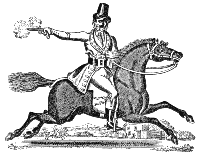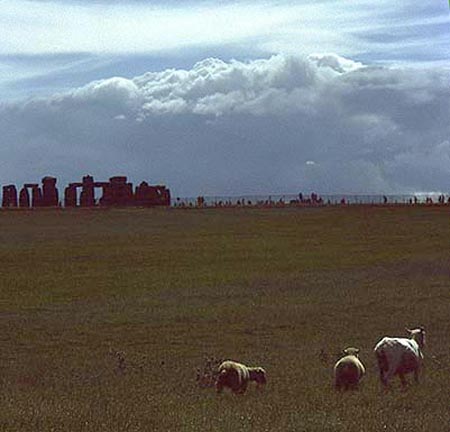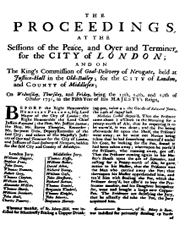|
Hovering For Unlawful Gain

From the time of Henry VIII onwards, travelling became much easier for ordinary folk.. This was because the post offices,
which before Henry were only used by Royal messengers, allowed the ordinary traveller to leave his own horse or carriage horse
and continue his journey on one of the post horses, provided he guaranteed to make the corresponding exchange on the way back.
Travelling on the Wiltshire roads during the sixteenth. seventeenth and eighteenth centuries was quite a dangerous adventure
though; floods often swept travellers off the roads; highwaymen possessed horses far swifter than the average; there were
few regular police and authority was mainly provided by the "hue and cry" .... the duty of citizens to share in the chase
after a lawbreaker. The end of the Civil Wars, the Peace of Ryswick at the end of the 17th C, the end of the French wars
of the 18th C, these were periods of maximum lawlessness, and people became accustomed to highwaymen. Strangely, there arose
a tradition they were no ordinary criminals. but "Gentlemen of the Road." A robber named Biss, hanged at Salisbury in 1695,
started the legend of the Highwayman as Robin Hood. Biss was supposed to have belonged to a good family (Sir Walter Biss,
parson of Bishopstrow). A "Gentleman of the Road"; well dressed, riding a good horse, carrying expensive weapons. William
Davies, known as the Golden Farmer was a contemporary of Biss and spent nearly forty years galloping around Salisbury Plain
as a highway robber. He was hanged at Tyburn in 1689. Throughout the 18th C, there was a famous gang of highwaymen at Cher
Hill and one of these is reported to have gone upon his marauding expeditions without a stitch of clothing, as he said that
not only did this frighten people on a dark night, but also that a naked man was less easily recognised. The most famous
of the Wiltshire highwaymen was Thomas Boulter, son of a Poulshot miller. He became a highwayman in 1775 and was hanged at
Winchester in 1778 at the age of 30. Thomas Boulter was a hero in Wiltshire. Striking appearance, fair hair, good figure,
clothes by the smartest tailor, a famous horse named Back Bess (often confused with Dick Turpin's horse), expensive weapons
and Good Manners. In the burial register at Maddington an entry reads "William Lawne, sonne off Giles Lawne barbarously
slaine neere the Windemill, Sept 23rd, and buryed the 24th of the same, 1666." Canon Lowther wrote in 1900 the story of Lawne.
Lawne took a large sum of money at Warminster Market and an ostler of the Inn where he stayed knew this, followed him and
shot him at the Gibbet. The murderer was apprehended and hanged in chains and there grew a tradition that nothing would grow
on this site. When looking at the Blind House in Shrewton one can imagine that last short trip for the condemned man
|
Never Without A Thief or Twain
Salisbury Plain,
Salisbury Plain,
Never without a thief or twain,
Never without a highwayman
To hover for unlawful gain
You travel with your watchful eyes,
Alert to any grim surprise,
Should a gunshote split the skies,
You whip your horse, away she flies
The robber stones that catch the eye
Are testament that some will die,
And some in transport ships will lie,
'Tis comfort as you ride on by.
So watch the brushwood when you ride,
It's there that thieves and robbers hide,
You trust in God to be your guide,
But keep your pistol by your side.
©Phil Beer/Ashley Hutchings |
|
 |
|

Highwaymen
the companion website to
2001
The first execution at Tyburn
took place in 1196, the last in 1783.
The first hangings were carried
out from tree branches on the bank
of the Tyburn River, but in 1220
a pair of gallows were
built on the site. The Triple Tree
(the name given to the gallows)
was built in 1571, and removed in
1759 because it was
obstructing the highway.
A mobile gallows was used
until public executions
ceased there........the fate of
many a highwayman
Salisbury Plain
the BBC comes through again.
God Bless'em
English Nature conservation at work
the hole truth about roundhouses
and other matters.

|
 |
 |
 |
|

One of the most interesting websites
to appear on the internet in
a good long time.
A fully searchable online edition
of the largest body of texts
detailing the lives of non-elite
people ever published,
containing accounts of over
100,000 criminal trials held
at London's central criminal court.
|
|
 |
 |
 |
|
|
|

